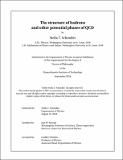The structure of hadrons and other potential phases of QCD
Author(s)
Schindler, Stella T.
DownloadThesis PDF (14.14Mb)
Advisor
Stewart, Iain W.
Terms of use
Metadata
Show full item recordAbstract
Quantum chromodynamics (QCD) is a mathematical theory describing subatomic particles called quarks and gluons, and the strong force that binds them together into protons and neutrons. This thesis centers on two major thrusts of modern QCD research: (1) uncovering the inner quark and gluon structure of the proton, and (2) mapping out other phases of matter that quarks and gluons form as we vary pressure and temperature. To study these topics, we develop, utilize, and synergize tools in quantum field theory (analytics), lattice gauge theory (numerics), and phenomenology (comparing theory to experiment). Specifically, we use new and existing techniques to access precision information about the inner structure of the proton, via the study of transverse momentum distributions, energy correlators, and diffractive processes at colliders. Additionally, we develop new analytic and numerical techniques for studying QCD phase structure inspired by non-Hermitian physics, and probe the possibility of new exotic phases near the QCD phase transition.
Date issued
2024-09Department
Massachusetts Institute of Technology. Department of PhysicsPublisher
Massachusetts Institute of Technology